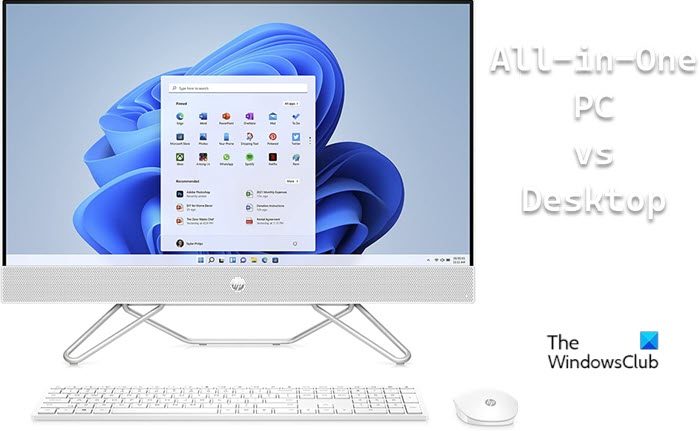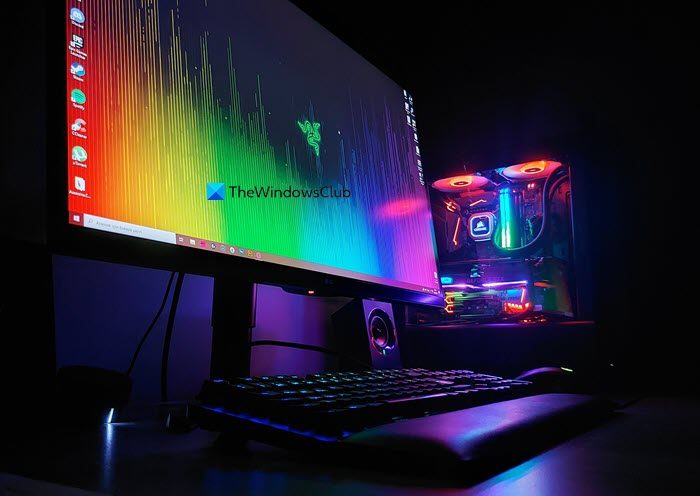All-in-One PCs have gained a lot of popularity lately. They are slim, look good, have a decent screen, and come with their keyboard and mouse. So, the question arises, are they ready to replace our Desktops? Or are they just a pretty piece of tech that looks good sitting on your desktop? In this post, we will answer all your questions. We will do All-in-One PC vs Desktop, and see what’s better for you.

What are All-in-One Personal Computers?
All-in-One or AiO PCs are nothing but all the components of your desktop packed in a smaller form factor. Desktop computers have a separate Monitor and CPU, but AiO’s monitors have integrated CPUs. Also, most of the AiOs come with their own Bluetooth Keyboard and Mouse, so you won’t have to buy them separately. As a result of these things, AiOs are much smaller and less power-consuming than your average desktop PC.
Unlike Desktop PCs, AiOs don’t have the normal components; instead, most of them are shrunk to fit into a smaller chassis. This drops the performance significantly as there is not enough room to add a cooling system. However, not many users will notice the difference in performance; only when you try to push the system to its extreme will you notice thermal throttling and a dip in performance.
After this, we are going to discuss the difference between All-in-One PC and Desktop and will compare them on multiple parameters to know which one is for you.
All-in-One PC vs. Desktop
In this battle, All-in-One PC vs Desktop, we are going to make the comparison based on the following parameters.
- Aesthetics
- Performance
- Touch options
- Price
Let us talk about them in detail.
1] Aesthetics

All-in-One PCs are made to look good. They have this slim monitor stuffed with all the CPU components; also, the keyboard and mouse follow that slim form factor. On top of that, because there are not many ports, the cable management is easier and hence, makes the whole setup look clean. This by no means implies that Desktops look bad. Nowadays, you can find good RGB stuffed CPUs and good quality monitors. That being said, most people will like the slim form factor of All-in-One PCs. So, they take the cake in this round.
2] Performance

This is the area where the Desktop shines the most. It is pretty common sense, you need big powerful internals, and best-in-class cooling, you would need a big chassis to stuff all of them in. However, you first need to know the demand of your workflow. Most people won’t need the best GPU and the overpowered CPU if all they do is create Word documents and check their E-Mails. But if you are a power user, like, you need to play games on your computer or edit 4K videos, a full-fledges Desktop PC is what you need.
All-in-One PCs don’t have the same cooling system that a Desktop has, because of which, your system may experience thermal throttling. Also, it’s very unlikely that they will have the best-in-class GPU because of the lack of space.
If we talk about raw performance, Desktop PC is far superior to All-in-Ones, but most people don’t need god-tier performance.
Read: Improve Windows 11 Performance by tweaking these 5 settings
3] Touch options
Touch Display is not a necessity, but a luxury for most PC users as all the versions of Windows OS are optimized to work with a laptop and a mouse. When it comes to Desktop PCs, the touch option depends on the monitor, if you want a touch screen, attach a suitable display. AiOs, on the other hand, come in both regular and touch options. But the problem with Desktops is that you will end up paying extra to get the touchscreen
If you are an artist or a graphics designer and want a touch screen to use the monitor as your canvas, bear in mind that since the AiO has all its components behind the monitor, the degree of flexibility will be less compared to that of an actual monitor that you get in Desktop PC.
Read: How to download or update HID compliant touch screen driver
4] Price
Price is where things start getting interesting. AiOs are generally more expensive than a tower PC. So, you will get a much superior desktop PC for the price of an inferior AiO. There are various reasons for the same, to build an AiO, exceptional engineering is required, you can’t just stack components as you would in a tower CPU, because of the lack of space. Also, you are getting a full fledge computer in AiO, which would include Monitor, Speakers, Mouse, Keyboard, and sometimes, even a webcam.
So, you should calculate the price of both devices before making a decision. Yes, Tower PCs are relatively inexpensive, but add the price of every device and then decide.
Are desktops better than All-in-Ones?
When it comes to performance, Desktop exceeds All-in-Ones by all metrics. It usually has a more powerful chipset, has a better cooling system, and if you feel like upgrading your hardware, a tower PC makes it more accessible. But when it comes to being better overall, it is just personal preference, if you want a slim, aesthetically pleasing, but not-so-powerful computer, get an AiO.
On the other hand, if you are a power user and do a lot of editing and gaming, get a full-fledged desktop PC. It all depends on your needs and wants.
What are the disadvantages of All in One Computers?
All-in-One Computers have the following disadvantages.
- They lack power and a cooling system; hence, they can’t run any demanding title or intensive tasks.
- Usually, they are not upgradeable. And even if they are upgradable, doing so won’t be as easy as it would be on a Desktop computer.
- You will end up paying more for an AiO for the same specs than a desktop computer.
That being said, AiO is by no means a bad option and should be considered for users who don’t need the utmost specification.
Read: Laptop vs Desktop – Which is better? Differences discussed.
Leave a Reply